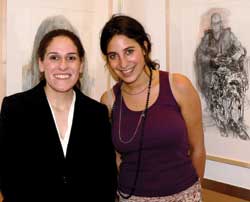Celebrating the divine in the everyday

Suzanne Rackover (left) and Jacqui Sischy curated complementary shows as part of the Blessings in Art event over the May 10th weekend. The two are in front of drawings by Marion Wagschal featured in Rackover’s exhibit. A full list of artists is available at: art-history.concordia.ca
Photo by Marc Losier
The Departments of Art History and Religion joined forces this month to explore Judaism and blessing.
“Religion is seldom brought into courses in art history,” Loren Lerner, Chair of that department, commented at the end of a May 14 symposium. “Modernism rejects religion or mysticism. If it’s mentioned at all, it’s to be critical of religious content.”
Yet according to Suzanne Rackover (MA, Art History 03), curator of one of two exhibits held concurrent to the symposium in the Temple Emmanu-El-Beth Sholom, “The role of brachot, blessings, in Jewish life, culture and theology is profound and manifold.”
Meanwhile, Jacqui Sischy, a student in the department’s master’s program, curated an exhibit bringing together a series of artifacts from around the world.
“Each of these objects is a carrier of personal and social meanings,” she said. Lerner added, “Religion is a marker of identity, like gender, race or class.”
Norman Ravvin, Chair of the Concordia Institute for Canadian Jewish Studies (a co-sponsor of the event), summed up the place of blessings in Jewish life as “the relationship between the human and divine world.”
This theme was addressed by all of those who spoke at the symposium.
Rabbi Howard Joseph, of the Religion Department and Canada’s oldest synagogue, the Spanish and Portuguese Synagogue of Montreal, ruminated on this relationship between daily events and the divine. “Religion challenges us to bring the holy in.”
That relationship was further explored by Rabbi Leigh Lerner, in whose temple the events were held. He explored the role of the reform movement in facilitating the relationship between the congregation and religion. In particular, he considered the impact of changing the content and language of prayer. For some, this shift is too secular, but it means that “the heart of the worshipper may know what the lips speak.”
Norma Joseph, Chair of the Department of Religion, made an even more concrete link between the holy and the ordinary. She told the audience, made up of Concordians and members of the congregation, that “food was at the ritual core of our ceremonies” both in its symbolic role and as concrete nourishment.
She stressed the importance of women as providing a connection between the worldly and religious planes, acknowledging that women themselves downplay the importance of this link.
She quoted a woman’s prayer for preparing Sabbath challah as the ultimate negotiation between individual and God and as an example of “the holy embedded in the daily.”
Ravvin’s talk on the place of the kaddish in literature expanded on the notion of blessing in art. Touching on the role this exaltation of God has in the ritual around death he considered this prayer’s treatment in numerous works of fiction.
For some writers, like A.M. Klein and Mordecai Richler, the kaddish is described faithfully as a mourning ritual. Allen Ginsberg’s poem, written after his mother died, takes a much more experimental and “personalized view of self and relationship to community.” Yet, in all cases, those unfamiliar with Judaism would not understand the blessing.
The exhibit curated by Rackover also does not share a specific perspective on blessing and faith. Instead, it invites the viewer to consider multiple interpretations. The event was also sponsored by the Bronfman Family Foundation.